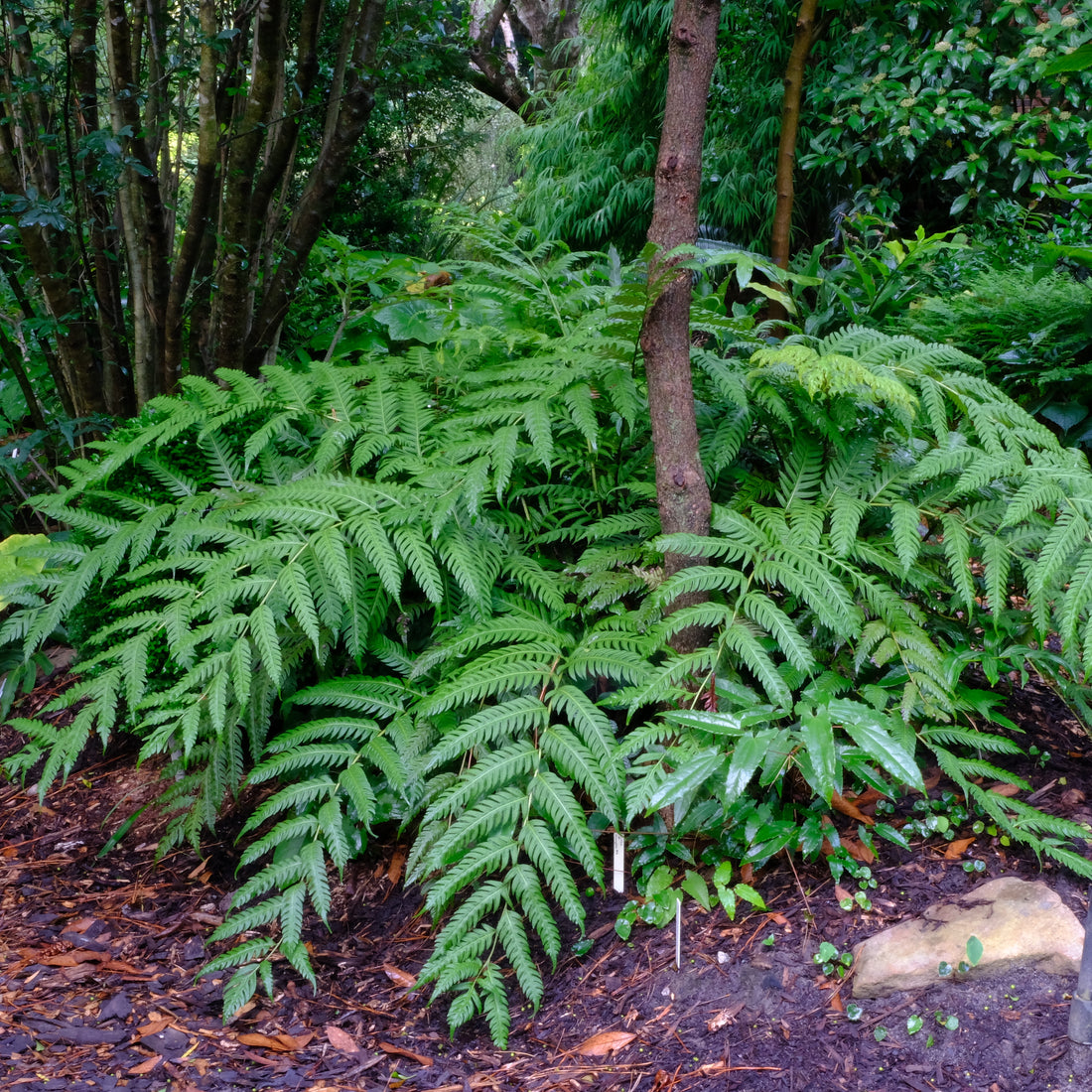The genus Woodwardia, also known as chain fern, is named after British botanist Thomas J. Woodward (1745-1820). Woodwardia has traditionally been used as a “catch all” genus for ferns in the family Blechnaceae that all share a strange venation pattern in common. The veins on either side of the midribs anastomose to form elongate “chains.” Today we know that the American species that were formerly placed in this genus are not as closely allied with the Asian species as once thought and species like the Netted Chain Fern belong to a more ancient lineage that is basal (related at the lowest portion) of the family tree that leads to the core of the genus Woodwardia. As understood today, the genus includes 14 species and their hybrids, most native to warm temperate and subtropical areas in the Northern Hemisphere. There are only three species that are commonly in cultivation. The immense size that many of the Asian species attain make them among the most dramatic foliage plants that can be utilized in our woodland gardens.
Woodwardia Varieties
Lorinseria areolata aka Woodwardia areolata (Netted Chain Fern) Netted Chain Fern is one of the most durable American native ferns. Though it is similar in growth habit and appearance to the Sensitive Fern, Onoclea sensibils, it is not related, and the leaves are typically much darker and glossier. Netted Chain Fern produces dimorphic fronds, meaning that the sterile fronds look different from the fertile fronds. The fertile (spore-producing) fronds have very narrow pinnules that make the fronds appear skeletal. The deciduous Netted Chain Fern is rhizomatous and can colonize large areas of woodland gardens. In the wild, it is found in moist and seasonally flooded soils, although it can tolerate drier soils with occasional irrigation. The 18” tall upright sterile fronds are highlighted by 20” tall, attractive sterile fronds in the summer months. (Hardiness Zone 3a-10b)
Woodwardia orientalis
Woodwardia japonica (Japanese Chain Fern) Woodwardia japonica is a little-known fern from Southern Japan and China. It is quite unique from the other Woodwardia that we have grown with its 4’ long evergreen leaves (in warmer regions) which usually emerge with a nice orangish-pink flush. Unlike the other Asian species we cultivate, this one does not produce bulbils or plantlets on the fronds. Given an organic-rich, moist soil this fern will obtain a supreme presence among the ferns of your woodland garden. (Hardiness Zone 7b-10b, at least)
Woodwardia orientalis (Oriental Chain Fern) This large evergreen (in warmer zones) fern is perfect for adding a touch of the tropics to your temperate garden. Hailing from Japan and China, Woodwardia orientalis can be found growing on moist hillsides. Although slow to reach mature size, when happy, Woodwardia orientalis will eventually reach 4' tall by 6' wide, and up to 12’ wide in frost-free climates). When the plants mature, the glossy fronds are topped with hundreds of small plantlets, which can be removed for propagation. (Hardiness Zone 7b-10)
Woodwardia unigemmata (Oriental Walking Fern) Woodwardia unigemmata makes a huge specimen to 2' tall by 6' wide. Although most forms of this have not been winter hardy in our trials, new Chinese genetics from plantsman Hans Hansen have proven much hardier here. The 3' long fronds often emerge tinted red and as they mature and produce 1-3 plantlets along the central stipe, which can root down into the soil. These plantlets appear as brown, fuzzy bulbils and give the scientific and common name to this plant—unigemmata, meaning one jewel = one new plant bulbil. Moist, rich soils result in the best performance. (Hardiness Zone 7b-9b)
Anchistea virginica aka Woodwardia virginica (Virginia Chain Fern) Woodwardia virginica is a wonderful US native, from ME to TX, is strangely missing from gardens despite being a great, easy-to-grow garden specimen. Woodwardia virginica is usually found in very acidic soils of bogs and pocosins, but we have found it quite adaptable in common garden conditions. Woodwardia virginica has a long, creeping, deciduous rhizome that is topped during the growing season with vertical black stipes and upright 18" green fronds that often emerge coppery red. Woodwardia virginica is a nice spreader. Our 5-year-old patches are 4' wide. This species is often host to leaf roller moths that roll the pinnules up into a little round “tent” by the developing larvae. (Hardiness Zone 3a-10b at least)

